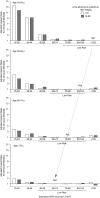CKD: A Call for an Age-Adapted Definition
- PMID: 31506289
- PMCID: PMC6779354
- DOI: 10.1681/ASN.2019030238
CKD: A Call for an Age-Adapted Definition
Abstract
Current criteria for the diagnosis of CKD in adults include persistent signs of kidney damage, such as increased urine albumin-to-creatinine ratio or a GFR below the threshold of 60 ml/min per 1.73 m2 This threshold has important caveats because it does not separate kidney disease from kidney aging, and therefore does not hold for all ages. In an extensive review of the literature, we found that GFR declines with healthy aging without any overt signs of compensation (such as elevated single-nephron GFR) or kidney damage. Older living kidney donors, who are carefully selected based on good health, have a lower predonation GFR compared with younger donors. Furthermore, the results from the large meta-analyses conducted by the CKD Prognosis Consortium and from numerous other studies indicate that the GFR threshold above which the risk of mortality is increased is not consistent across all ages. Among younger persons, mortality is increased at GFR <75 ml/min per 1.73 m2, whereas in elderly people it is increased at levels <45 ml/min per 1.73 m2 Therefore, we suggest that amending the CKD definition to include age-specific thresholds for GFR. The implications of an updated definition are far reaching. Having fewer healthy elderly individuals diagnosed with CKD could help reduce inappropriate care and its associated adverse effects. Global prevalence estimates for CKD would be substantially reduced. Also, using an age-specific threshold for younger persons might lead to earlier identification of CKD onset for such individuals, at a point when progressive kidney damage may still be preventable.
Keywords: chronic kidney disease; epidemiology and outcomes; glomerular filtration rate.
Copyright © 2019 by the American Society of Nephrology.
Figures




Comment in
-
Does eGFR by Any Number Mean the Same?J Am Soc Nephrol. 2019 Oct;30(10):1806-1807. doi: 10.1681/ASN.2019070749. Epub 2019 Sep 10. J Am Soc Nephrol. 2019. PMID: 31506291 Free PMC article. No abstract available.
-
Age-Dependent Definition of CKD.J Am Soc Nephrol. 2020 Feb;31(2):447. doi: 10.1681/ASN.2019090914. Epub 2019 Dec 23. J Am Soc Nephrol. 2020. PMID: 31871272 Free PMC article. No abstract available.
-
Authors' Reply.J Am Soc Nephrol. 2020 Feb;31(2):448-449. doi: 10.1681/ASN.2019111188. Epub 2019 Dec 23. J Am Soc Nephrol. 2020. PMID: 31871273 Free PMC article. No abstract available.
-
Current CKD Definition Takes into Account Both Relative and Absolute Risk.J Am Soc Nephrol. 2020 Feb;31(2):447-448. doi: 10.1681/ASN.2019101049. Epub 2019 Dec 23. J Am Soc Nephrol. 2020. PMID: 31871274 Free PMC article. No abstract available.
References
-
- Kidney Disease: Improving Global Outcomes (KDIGO) Chronic Kidney Disease Work Group : KDIGO 2012 clinical practice guideline for the evaluation and management of chronic kidney disease. Kidney Int Suppl 3: 1–150, 2013 - PubMed
-
- Delanaye P, Schaeffner E, Ebert N, Cavalier E, Mariat C, Krzesinski JM, et al. .: Normal reference values for glomerular filtration rate: What do we really know? Nephrol Dial Transplant 27: 2664–2672, 2012 - PubMed
-
- Poggio ED, Rule AD: Can we do better than a single estimated GFR threshold when screening for chronic kidney disease? Kidney Int 72: 534–536, 2007 - PubMed
-
- Tonna SJ: Invited commentary: Defining incident chronic kidney disease in epidemiologic study settings. Am J Epidemiol 170: 425–427, 2009 - PubMed
Publication types
MeSH terms
Grants and funding
LinkOut - more resources
Full Text Sources
Medical
Miscellaneous

